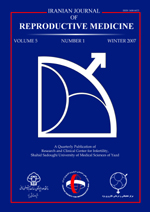
|
International Journal of Reproductive BioMedicine
Research and Clinical Center for Infertility, Shahid Sadoughi University of Medical Sciences of Yazd
ISSN: 1680-6433
EISSN: 1680-6433
Vol. 11, No. 7, 2013, pp. 565-576
|
 Bioline Code: rm13071
Bioline Code: rm13071
Full paper language: English
Document type: Research Article
Document available free of charge
|
|
|
International Journal of Reproductive BioMedicine, Vol. 11, No. 7, 2013, pp. 565-576
| en |
Nonoxynol-9 berberine plural gel has little effect on expression of SLPI, SP-D and lactoferrin in mice’s vagina
Yuan, Qiao; Zhuo, Chen; Yonggui, Ma; Fuer, Lu; Suhua, Chen & Guangying, Huang
Abstract
Background: The most frequently used spermicide Nonoxynol-9 (N-9) in the clinic alters the vaginal flora, which will result in an increased risk of opportunistic infection. So development of a novel spermicidal and microbicidal drug appears to be inevitable. Vaginal local immune is an important part of vaginal flora. Secretory leukocyte protease inhibitor (SLPI), surfactant proteins D (SP-D), and lactoferrin (LF) are anti-microbial molecules with important roles in immune system of female vaginas.
Objective: To observe effect of a vaginal spermicide nonoxynol-9 (N-9) berberine plural gel on the expression of SLPI SP-D and LF in mice’s vaginas.
Materials and Methods: Female BABL/C mice were randomly divided into following 5 groups: normal control group, blank gel group, berberine gel group, 12% N-9 gel group and N-9 berberine plural gel group. Estradiol benzoate at physiological dose was done by hypodermic injection to every group’s mice. After 72h, drug gels were separately injected into the mice’s vaginas, while immunohistochemistry and Western blot were taken to detect the expression of the 3 indexes in mice’s vaginas respectively after 24h and 72h of gel injection.
Results: The differences in the three indexes between normal control group and blank gel group were not significant statistically (p>0.05). The expression of the three indexes in 12% N-9 gel group was decreased compared to that in blank gel group (p<0.05). The differences in the three indexes between N-9 berberine plural gel group and blank gel group were not significant statistically (p>0.05). Also, the three index's level of 24h and 72h in sub observation groups after treatment were without statistical significance (p>0.05).
Conclusion: Application of N-9 berberine plural gel had little impact on antimicrobial peptides in normal mice’s vaginas.
Keywords
Vagina; Anti-infective agents; Mice; Berberine; Nonoxynol-9
|
| |
© Iranian Journal of Reproductive Medicine
Alternative site location: http://www.ijrm.ir
|
|
